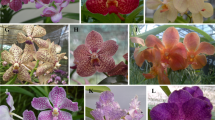Abstract
Callus cultures from cotyledon and hypocotyl explants of a Spanish cultivar of melon (‘Amarillo Oro’) have been tested for their growth and morphogenic capacity on a series of media with different concentrations of indole-3-acetic acid (IAA) and 6-furfurylaminopurine (kinetin). Melon tissues were able to undergo morphogenesis both via organogenesis and embryogenesis, depending on culture conditions and explant source. Shoot buds were obtained at high rates in cotyledon explants. In response to 1.5 mg/l IAA and 6.0 mg/l kinetin, more than 90% of the calli produced well-developed shoots. Hypocotyls failed to form shoots but formed somatic embryos on auxin containing media while cotyledon explants usually gave abundant shoots but only rarely formed embryos. It was possible to maintain organogenic callus lines for at least 12 months under defined conditions. Plants were recovered from adventitious shoots produced both in cotyledon-derived calli and from organogenic cell lines.
Similar content being viewed by others
References
Fadia VP, Mehta AR (1973) Tissue culture studies on Cucurbits: growth and nutrition of Cucumis melo L. callus cultures. Indian J Exp Biol 11:424–426
Fadia VP, Mehta AR (1975) Tissue culture studies on Cucurbits: factors limiting growth of Cucumis melo L. Tissue grown as batch cultures. Indian J Exp Biol 13:590–591
Fadia VP, Mehta AR (1976) Tissue culture studies on Cucurbits: chlorophyll development in Cucumis callus cultures. Phytomorphology 26:170–175
Hermann EB, Haas GJ (1978) Shoot formation in tissue culture of Lycopersicon esculentum Mill. Z Pflanzenphysiol 89:467–470
Jelaska S (1974) Embryogenesis and organogenesis in pumpkin explants. Physiol Plant 31:257–261
Jelaska S (1980) Growth and embryoid formation in Cucurbita pepo callus cultures. In: Eucarpia R, Legumes S (eds) Application de la culture in vitro à l'emélioration des plantes potagères, pp 172–178 (Versailles)
Larkin PJ, Scowcroft W (1981) Somaclonal variation: a novel source of variability from cell cultures for plant improvement. Theor Appl Genet 60:197–214
Larkin PJ, Brettell R, Ryan S, Scowcroft W (1983) Protoplasts and variation from culture. Proc 6th Int Prot Symp ‘Protoplasts 1983’ Experientia Supplementum 46:51–56
Moreno V, Zubeldia L, Roig LA (1984) A method for obtaining callus cultures from mesophyll protoplasts of melon (Cucumis melo L.). Plant Sci Let 34:195–201
Murashige T, Skoog F (1962) A revised medium for rapid growth and bioassays with tobacco tissue cultures. Physiol Plant 15:473–497
Vajranabhaiah SV, Mehta AR (1976) Studies on nucleic acid metabolism in suspension cultures of Cucumis melo L. Ann Bot 40:339–346
Vajranabhaiah SN, Mehta AR (1977) Effect of kinetin on growth and nucleic acid metabolism in suspension cultures of Cucumis melo L. Ann Bot 41:483–491
Author information
Authors and Affiliations
Rights and permissions
About this article
Cite this article
Moreno, V., Garcia-Sogo, M., Granell, I. et al. Plant regeneration from calli of melon (Cucumis melo L., cv. ‘Amarillo Oro’). Plant Cell Tiss Organ Cult 5, 139–146 (1985). https://doi.org/10.1007/BF00040310
Received:
Accepted:
Issue Date:
DOI: https://doi.org/10.1007/BF00040310




